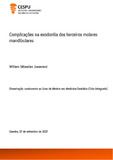| dc.contributor.advisor | CÂMARA, MARCO PAULO DE ARAÚJO INFANTE DA | |
| dc.contributor.author | Josserand, William Sebastien | |
| dc.date.accessioned | 2022-02-10T13:54:02Z | |
| dc.date.available | 2022-02-10T13:54:02Z | |
| dc.date.issued | 2021 | |
| dc.identifier.uri | http://hdl.handle.net/20.500.11816/3892 | |
| dc.description.abstract | Objetivo: Esta revisão integrativa pretende descrever as complicações que podem ocorrer em relação as extrações dos terceiro molares mandibulares e identificar os principais fatores de risco.
Materiais e Método: foi efetuada uma pesquisa bibliográfica nas plataformas de busca (bases de dados) para expor as complicações mais comuns relacionadas com a extração dos terceiro molares e, identificar os factores de risco associados. A revisão foi feita utilizando os motores de busca científicos Pubmed e Cochrane Library. Inicialmente encontrei 56 artigos e após várias seleções seleccionei 20 artigos.
Resultados: Analizando os resultados da incidência da alveolite, observamos que temos valores que variam muito desde 0,19 até ao 19,5%. Sobre a incidência das infecções pôs-operatórias podemos encontrar uma média que esta compreendida entre 0,4 a 4,5% com valores que ficam parecidos entre estudos. Relativamente à incidência das lesões nervosas, que podem envolver o nervo alveolar inferior e o nervo lingual, temos valores muito diferentes, mas que na literatura concordam a dar uma média de 0,4 até 9% para lesão do nervo alveolar inferior e de 0 a 23% para o lingual. Sobre a incidência da hemorragia podemos observar dados semelhantes, compreendidos entre os 0,5 e 1,2%.
Conclusão: Atualmente, as extrações são uma das cirurgias mais comuns praticadas pelos dentistas e, como noutros procedimentos cirúrgicos comuns, podem surgir complicações durante a cirurgia ou no pós-operatório. Mesmo com meios auxiliares sempre mais eficazes, as extrações devem ser um trabalho bem planejado e com follow-up cuidadoso dos pacientes. | pt_PT |
| dc.description.abstract | Purpose: This integrative review aims to describe the complications that may occur in relation to the avulsions of the third molars and identify the main risk factors.
Materials and method: a bibliographical search was carried out on the search engines (databases) to expose the most common complications related to the extraction of third molars and to identify the associated risk factors. The review was made by the scientific website PubMed and Cochrane Library. Initially were founded 56 articles and after several selections were selected 20 articles.
Results: Analyzing the results of the incidence of alveolite, we observed that we have values that vary widely from 0.19 to 19.5%. On the incidence of postoperative infections, we can find an average that is between 0.4 and 4.5% with values that are similar between studies. Regarding the incidence of nerve lesions, which may involve the lower alveolar nerve and the lingual nerve, we have very different values, but in the literature agree to give an average of 0.4 to 9% for lower alveolar nerve injury and from 0 to 23% for the lingual. On the incidence of bleeding, we can observe similar data, between 0.5 and 1.2%.
Conclusion: Currently, the avulsions are one of the most common surgeries performed by dentists and, as in other common surgical procedures, complications may arise during surgery or in the postoperative period. Even with ever more effective auxiliary tools, extractions should remain a well-planned job and with careful follow-up of patients. | pt_PT |
| dc.language.iso | por | pt_PT |
| dc.rights | info:eu-repo/semantics/openAccess | pt_PT |
| dc.subject | Molar | pt_PT |
| dc.subject | Third | pt_PT |
| dc.subject | Extraction | pt_PT |
| dc.subject | Complications | pt_PT |
| dc.subject | Surgery | pt_PT |
| dc.subject | Nerve injury | pt_PT |
| dc.title | Complicações na exodontia dos terceiros molares mandibulares | pt_PT |
| dc.type | info:eu-repo/semantics/masterThesis | pt_PT |
| dc.identifier.tid | 202911985 | pt_PT |
| thesis.degree.name | Mestrado em Medicina Dentária | pt_PT |

